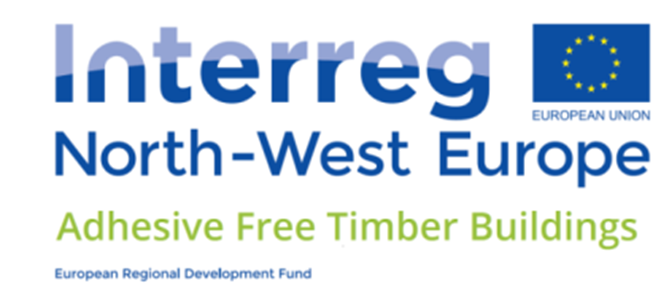Temps de lecture : 2 minutes
Towards Adhesive Free Timber Buildings (AFTB)
Start date: 01/01/2017
End date: 31/03/2020
Funder: Interreg V B NWE
Principal investigator: Dr. Marc OUDJENE (LERMAB, Université de Lorraine)
Academic partners: Dr. Z Guan (University of Liverpool), Dr. A. Harte (National University of Ireland Galway), Pr. P. Haller (Technische Universitat Dresden), Dr. S. Belouettar (Luxembourg Institute of Science and Technology) and F. Deneufbourg (Office Économique Wallon du Bois).
Objectives: Regulatory and customer pressure is driving an increasing need for sustainability in the construction sector. Replacing the glue in laminated timber products offers a route to this goal. The Towards Adhesive Free Timber Buildings project seeks to deliver this vision. Five million m3 of engineered wood products (EWPs) are produced in the EU annually and the market is growing as EWPs provide a ‘green’ alternative to steel and concrete. Despite the many benefits of EWPs, they have some drawbacks. EWPs have a high degree of petrochemical use in their manufacturing. In general, the production of one cubic meter of glulam timber requires 5kg of phenol-resorcinol-formaldehyde (PRF) and 1kg of melamine-urea formaldehyde (MUF). While the greatest environmental impact of these adhesives is during manufacture, their presence may significantly hinder the recycling/reuse potential of EWPs. Timber buildings are normally constructed using EWPs connected using steel connectors. Changing from steel to wood-based connection systems will enhance their environmental performance. To address this, a consortium with members from six European countries was formed to develop adhesive-free EWPs through a joint project supported by the Interreg NWE, a program of the European Union.
The project will:
- manufacture thousands of compressed wood dowels. The dowels are produced from pre-dried timber using a pressure of 200 ton/m2 at elevated temperatures. Various species native to north west Europe will be trialled;
- test the dowels individually before using them in the assembly of EWPs: CLT, beams and beam-beam connectors. These will then be tested and benchmarked against traditional glue-laminated products. Tests will include a full structural assessment as well as testing for fire resistance;
- employ numerical simulation via Finite Element analysis to guide the testing process and validate conclusions;
- construct three demonstrator structures in Dresden, Germany, Epinal, France and Liverpool, UK. These structures will rely on adhesive-free EWPs for their structure and will deliver a real world proof of the concept. Visits will be arranged for interested parties to see the products in use.



